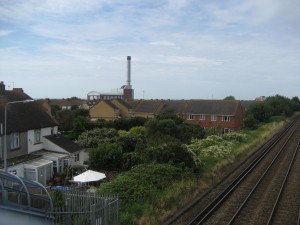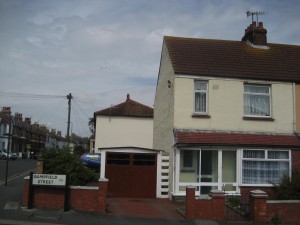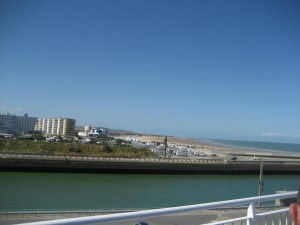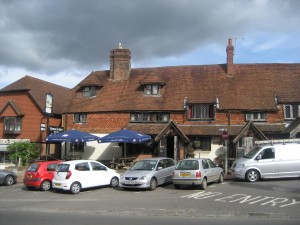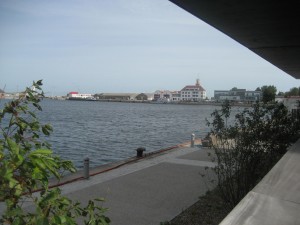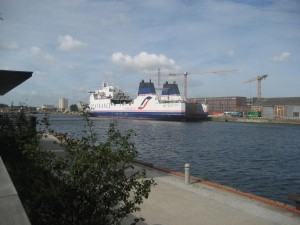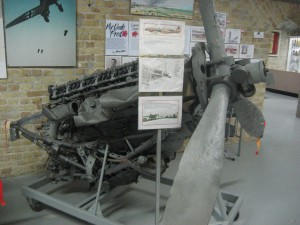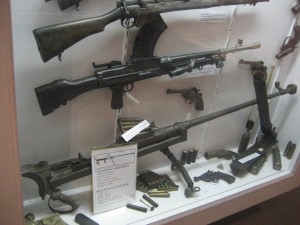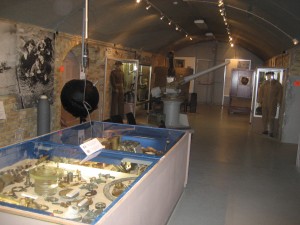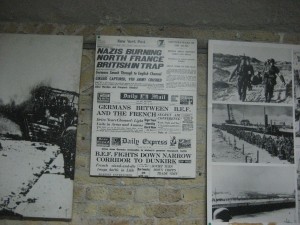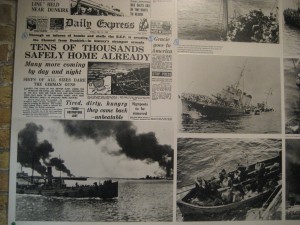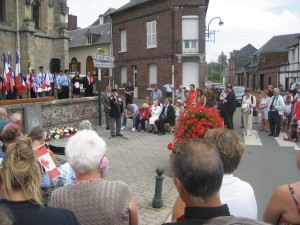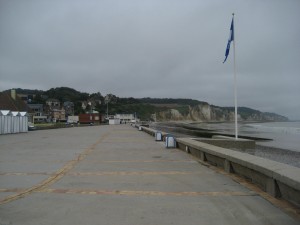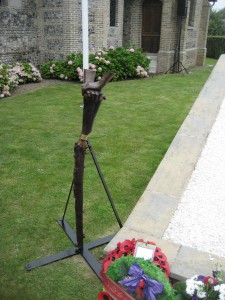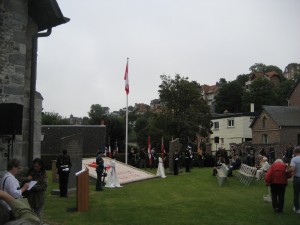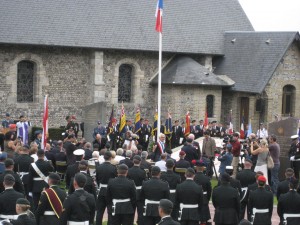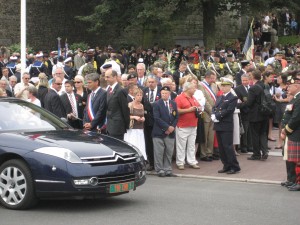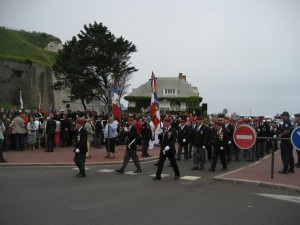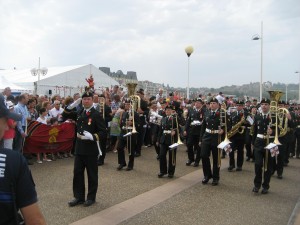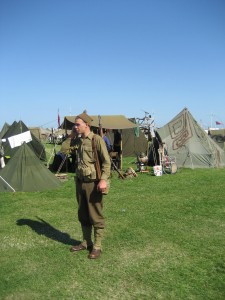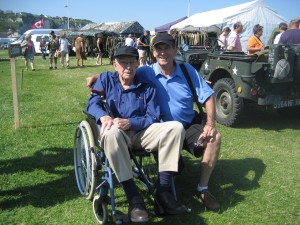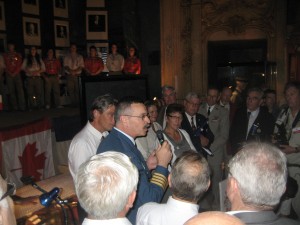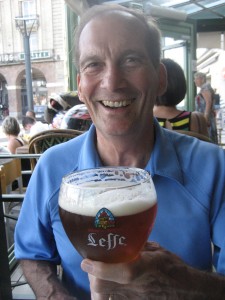Search
Gervais-Laekas Services
World War II, Les Fusiliers Mont-Royal, Dieppe
25 August – Research
For breakfast we have our usual cereal and Claudio brings us a plate full of toast. Johanne gets some marmalade and a little heart-shaped container of Marmite. “Try it,” she tells me. “It looks like Nutella.” I peel the flap back, dip the tip of my knife in the sticky, dark brown paste, and try it. “What does it taste like?” Without answering, I offer her the knife. I take a photo as she puts the Marmite on the tip of her tongue. She won’t let me post the picture. Marmite is a yeast extract, has a distinctive, powerful flavour, and is extremely salty –it tastes much like Bovril. Claudio explains that you’re supposed to put it on your toast – it’s really good he says. Hmmm – I think we’ll pass on this one. 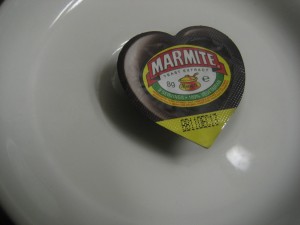
But enough about that. The Opole Central War Museum in Poland asked us if we could find a list for their museums of the Canadian Prisoners of War held at Stalags IID & VIIB. Johanne had contacted the Canadian Government, the Canadian War Museum, and Library and Archives Canada to no avail. In her research she found The National Archives in Kew, Surrey have an alphabetical list of Commonwealth Prisoners of War that is available for viewing, on a first come / first serve basis. Off we go to find The National Archives relying on our Google directions to get us there. Everything is fine until we come off the M25 and make our way through the various towns that stand in our way. Somehow, despite missing half of the Google instructions, we manage to get on the A307 that is supposed to lead us to Kew. Another missed turn and I end up going in circles in downtown Kingston. To right things I take a turn that will put us back on track and follow a police car into a Buses and Authorised Vehicles Only lane. I guess he had more important wrongdoers to pursue. Now there are no signs for the A307 and we haven’t a clue where we are. I’m about to stop and ask, when Johanne startles me with bird calls. It’s the plaintive call of the mourning doves we hear outside our window at the Chequers, though this call has a greater sense of urgency. “Kew, kew, kew.” She’s pointing at the sign ahead. Now I understand. I manage to get the car into the proper lane and we make our way down some narrow, winding roads towards Kew. The Google directions make no sense since we can’t find any street names posted anywhere so I stop on the busy Kew Road. A patron in a Barber Shop uses his iPhone GPS to get us oriented. According to him, The National Archives are a 15-minute walk away. Remembering my friend John Welbourn’s advice to look for a parking spot away from the Archives because their lot is usually full, we find an area that has metered parking in addition to permit holder parking. We park right across from the Kew Gardens and begin our trek. 30 minutes later, we see the sign for The National Archives.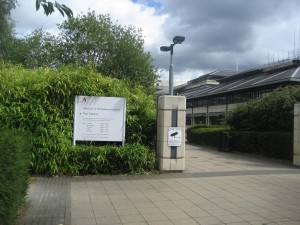 I can see the Archives parking lot hidden behind some shrubs nearby and it appears to be empty. I make a mental note to move the car once we get the POW records. Can’t wait to tell John that parking at the Archives wasn’t a problem. A young girl walking towards us stops us as we approach the entrance and shakes her head. “They’re closed for the Bank Holiday weekend.” WHAT! She tells us she’s discouraged for having spent an hour getting here by the Tube. Guess how we feel! It’s taken us 90 minutes not counting our 30-minute walk. Johanne’s annoyed that it’s closed for 3 whole days – she assumed it was only closed for the holiday Monday. “How could I have made such a silly mistake,” she laments. “What gives with the 3-day closure?” Oh well. We’ll get another chance later in the week when we return. We decide to make the best of a bad situation and have lunch at a little place called The Original Maids of Honour, a very quaint tea room.
I can see the Archives parking lot hidden behind some shrubs nearby and it appears to be empty. I make a mental note to move the car once we get the POW records. Can’t wait to tell John that parking at the Archives wasn’t a problem. A young girl walking towards us stops us as we approach the entrance and shakes her head. “They’re closed for the Bank Holiday weekend.” WHAT! She tells us she’s discouraged for having spent an hour getting here by the Tube. Guess how we feel! It’s taken us 90 minutes not counting our 30-minute walk. Johanne’s annoyed that it’s closed for 3 whole days – she assumed it was only closed for the holiday Monday. “How could I have made such a silly mistake,” she laments. “What gives with the 3-day closure?” Oh well. We’ll get another chance later in the week when we return. We decide to make the best of a bad situation and have lunch at a little place called The Original Maids of Honour, a very quaint tea room.  Good thing we stopped because the skies have just opened and the thunder rumbles overhead. The umbrella is in the car – Johanne didn’t want to bring it because there was nothing but blue sky when we began our walk to the Archives. We enjoy a delicious salmon quiche and roast chicken as we watch the rain come down. Both our meals come with spinach au gratin, something we’ve never eaten before – delicious!
Good thing we stopped because the skies have just opened and the thunder rumbles overhead. The umbrella is in the car – Johanne didn’t want to bring it because there was nothing but blue sky when we began our walk to the Archives. We enjoy a delicious salmon quiche and roast chicken as we watch the rain come down. Both our meals come with spinach au gratin, something we’ve never eaten before – delicious!
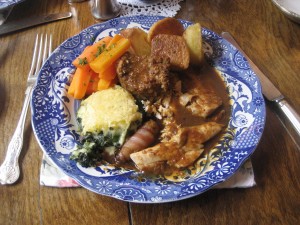 When the rain stops, Johanne tries to convince me to go to the Kew Gardens (the Royal Botanical Gardens) but I’m just not in the mood after the National Archives let down. And it’s probably going to rain again. We head back to the car, ducking under bus shelters when it starts to pour again.
When the rain stops, Johanne tries to convince me to go to the Kew Gardens (the Royal Botanical Gardens) but I’m just not in the mood after the National Archives let down. And it’s probably going to rain again. We head back to the car, ducking under bus shelters when it starts to pour again. 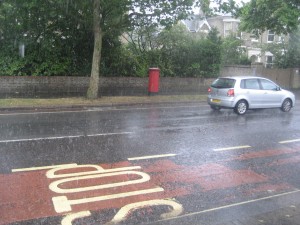 The ride home is not as much trouble as getting there because Johanne recognises some of the roads we should have been travelling on but missed on the way up. Tomorrow I’m looking forward to a relaxing day. After 3 days and several hundred miles of right-hand drive and left-hand gearshift on England’s highways, winding narrow roads, roundabouts, and getting honked when you screw up (only 3 times today that I know of), I’m ready for a break. Johanne, the organiser par excellence, is uneasy. “But what are you going to do?” which really means, “What are we going to do?” Tune in tomorrow to find how her question is answered.
The ride home is not as much trouble as getting there because Johanne recognises some of the roads we should have been travelling on but missed on the way up. Tomorrow I’m looking forward to a relaxing day. After 3 days and several hundred miles of right-hand drive and left-hand gearshift on England’s highways, winding narrow roads, roundabouts, and getting honked when you screw up (only 3 times today that I know of), I’m ready for a break. Johanne, the organiser par excellence, is uneasy. “But what are you going to do?” which really means, “What are we going to do?” Tune in tomorrow to find how her question is answered.
24 August – Portslade
We’ve had a last minute change of plans, our visit to see my cousin Viv will now take place later in the week. So today we plan to visit the town of Portslade, where my parents and I lived when my father returned from the war and married my mother (probably 1946). My sister Annabelle and brother Adrian were also born here. Also, it’s the town where my Uncle Mike and my Aunt Katherine lived for some time and where my cousin Michael was born. We have two houses to find, one on Eastbrook Way and the other on Bampfield Street. We start the day late for breakfast. Johanne discovers the hotel stops serving breakfast at 9:00 and according to our travel alarm, it is now 9:52. I am thinking of options when she makes another discovery – her watch says it is 8:52. She remembers putting her watch back when we landed but not the travel clock. While she gets ready for the day, I rush to the dining room to see what’s left. There I bump into Claudio and his friend Byron. Claudio sits and chats while I eat a bowl of cereal. I eventually make it back to our room with some cereal for Johanne who’s still not ready – bad hair day I think.
Today’s Google directions take us without a miscue to Port Slade about 1 hr away and a small dead-end street, Eastbrook Way.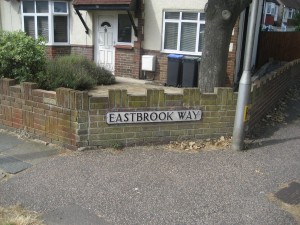
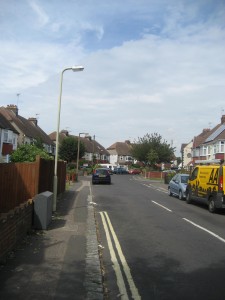 Apart from the sound of air-raid sirens, my earliest memories of England are here. I can remember riding my two-wheel scooter up and down the street. The house we lived in looks a bit run down. The lady living next door tells us the owner has moved and rents the house.
Apart from the sound of air-raid sirens, my earliest memories of England are here. I can remember riding my two-wheel scooter up and down the street. The house we lived in looks a bit run down. The lady living next door tells us the owner has moved and rents the house.
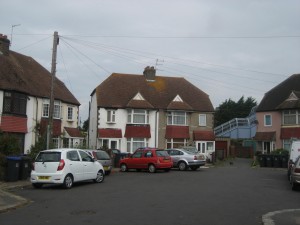
15 Eastbrook Way, semi-detach at the end of the road with a white facade. Notice the pedestrian railway overpass between the 2 blocks
There is no one home so I take Johanne to my next memory of this area, the pedestrian overpass that crosses the railway line behind the house and leads to the playing fields where my dad used to take me when he came home. I can remember climbing the stairs holding my dad’s hand and watching as the trains raced past beneath us. We used to walk down the other side to the sports field where we kicked a football (soccer ball) back and forth.

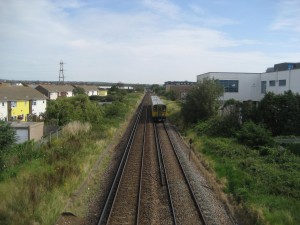 Not much else to see, but from our brief visit, I take away more than I brought.
Not much else to see, but from our brief visit, I take away more than I brought.
Finding Bampfield Street will be a bit more difficult. We can’t find the Google directions that I surely must have printed, or least I thought I did. As we leave Eastbrooke Way, I ask a man cutting his grass for directions. These take us to a development on the other side of the train tracks but we are unable to find Bampfield. I stop again and ask another man. He gets a Super Red Book of maps for Brighton, Shoreham, Seaford and Lewes. With Johanne’s help, he finds the street. To make sure we won’t get lost, he gives us his book and we’re off. A few minutes later we’re there in front of the tidy, little semi-detached with the garage my Uncle built.
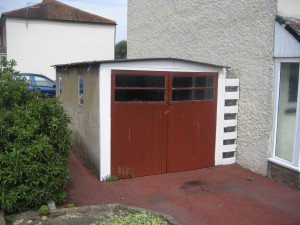
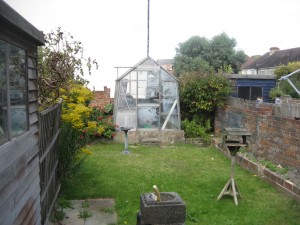
That’s it for today and we’re ready for lunch. We walk to three pubs, none of which were serving food. What’s up with that? I thought all pubs served food! Finally after 30 min of walking around we found an Italian restaurant on Station Road. We wanted to have a light lunch since last night at the Chequers, we over did it. I had sliced duck breast with blackberry and apple jus and Johanne had chicken wrapped in parma ham with a portobello sauce. That would have been enough but there were also two heaping bowls of potatoes (mashed & boiled) and vegetables. Could have fed a family of 4. So for lunch today we have a tasty carrot soup followed by delicious grilled sardines. The Iranian manager chats with us and brings complimentary digestifs, two small, chilled shot-glasses filled with a cloudy, yellow liquid. He says it is lemoncillo (an Italian lemon drink with vodka). We both down our drinks and remark how nice and refreshing it was until Johanne feels the after effects – the burn in her throat and up her nose. On our way back to the car, I take a photo of the Port Slade train station, where my father would take the train to his work in London. 
Satisfied we’ve accomplished today’s objectives, we start the drive home to the Chequers, looking forward to our traditional Friday night pizza.
Tomorrow we are off to the National Archives in London (actually Kew) to see if we could find a list of Canadians who were incarcerated in Stalag VIIIB and Stalag IID in Poland during WWII.
23 August – Dunkerque to Calais to Dover to Forest Row (East Sussex)
We set off from Dunkerque using Johanne’s extremely detailed Google directions to get to Calais. Amazingly, they took us out of town and onto the A26 without a bother. A quick stop at a service area to top up the car (the fellow at Avis Dieppe did say gazoil, didn’t he?) and then off to Calais. We by-pass the car ferry and get to centre-ville. We’re looking for Place d’Armes street but the signs are small, faded, and on the side of the brick buildings. We drive for a bit and Johanne says we must have passed it. She tells me to turn up a street to see what’s up there. I have a flashback to the Dunkerque fiasco and refuse. I make a U turn and pull over. “You’re too impatient,” she says. “I’m sure it’s just up there somewhere.” I walk back to the road to confirm that Avis is not just up there somewhere. We drive back from where we came and come to the road. We turn down and there, across from the square, is the red Avis sign. Johanne looks at me with an “I told you so” smile. I park, get the paperwork ready and my explanation as to why we are dropping the car off here and not in Dunkerque. Wouldn’t you just know it. The office is closed. A sign on the door explains their opening hours, during their vacation period. 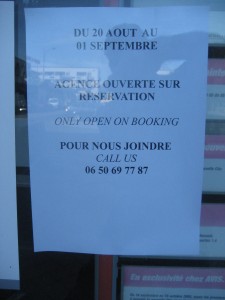 Of course, it couldn’t all just work out, could it? Okay, I’d better call them. As I walk back to the car to get a paper and pen, a woman approaches the office with papers in her arms and keys in her hands. All Right! She explains that during the vacation period, only one person serves the 2 offices in Calais and they shuttle back and forth. If we had been thirty minutes earlier or later, we would have missed her. I explain what happened and she just nods her head, asks if I filled the car, and we’re done. What an angel!
Of course, it couldn’t all just work out, could it? Okay, I’d better call them. As I walk back to the car to get a paper and pen, a woman approaches the office with papers in her arms and keys in her hands. All Right! She explains that during the vacation period, only one person serves the 2 offices in Calais and they shuttle back and forth. If we had been thirty minutes earlier or later, we would have missed her. I explain what happened and she just nods her head, asks if I filled the car, and we’re done. What an angel! 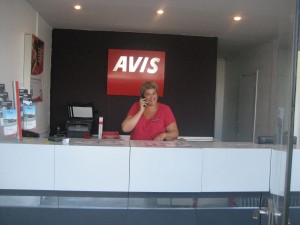 She calls for a taxi and ten minutes later, we are at the Calais ferry terminal. The process is much the same as an airport – tickets, security, customs & immigration, and wait in lounge area for a shuttle bus to take us to P&O’s Pride of Canterbury. We board. Johanne settles in, making sure she knows where all the exits are in case we hit an iceberg and sink like the Titanic. I leave her pondering where the lifejackets are and go above decks to take some photos.
She calls for a taxi and ten minutes later, we are at the Calais ferry terminal. The process is much the same as an airport – tickets, security, customs & immigration, and wait in lounge area for a shuttle bus to take us to P&O’s Pride of Canterbury. We board. Johanne settles in, making sure she knows where all the exits are in case we hit an iceberg and sink like the Titanic. I leave her pondering where the lifejackets are and go above decks to take some photos.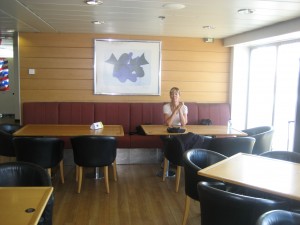
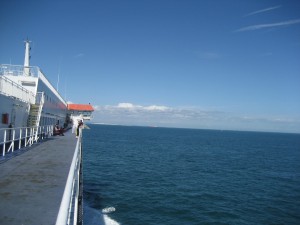

About 2 hours later, we arrive at Dover.
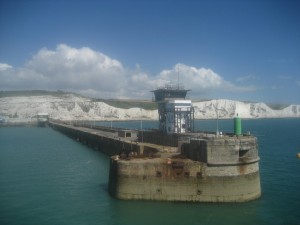 We follow passengers down the stairwells and end up where the cars and trucks are parked. Back up the stairs lugging our bags (good thing we only have carry-on) and we get off at the foot passenger deck. At the terminal, there are no taxis waiting. Johanne says it’s only 2 miles, we could walk! I think she’s crazy and walk to the public phone, but a taxi suddenly turns up. He says he was coming for another group but believes they have moved on. What luck! Five minutes later, we’re at the Alamo office in Dover. The fellow is surprised we’re there so early (reservation is for 4pm, it is 1:30pm) and our car hasn’t arrived. Rather than wait a couple of hours, he offers us a mini in place of the compact we reserved. We take it. I don’t realise Johanne thinks it a mini Cooper. She’s disappointed that it’s only a Hyundai 110 but it’s better than waiting another 3 hrs. While I’m taking care of the paperwork, Johanne takes the bags to the car. We’re ready to go and I open the passenger door to toss in the camera. I should have taken a photo. The privacy flap that hides what is stored in the hatchback compartment is lying askew over the back seats and the bags are all jammed in. “What?” she says. “The bags are in aren’t they?” And she thinks I’m impatient! 2.5 hours later without missing a turn, we arrive at the Chequer’s Inn in Forest Row.
We follow passengers down the stairwells and end up where the cars and trucks are parked. Back up the stairs lugging our bags (good thing we only have carry-on) and we get off at the foot passenger deck. At the terminal, there are no taxis waiting. Johanne says it’s only 2 miles, we could walk! I think she’s crazy and walk to the public phone, but a taxi suddenly turns up. He says he was coming for another group but believes they have moved on. What luck! Five minutes later, we’re at the Alamo office in Dover. The fellow is surprised we’re there so early (reservation is for 4pm, it is 1:30pm) and our car hasn’t arrived. Rather than wait a couple of hours, he offers us a mini in place of the compact we reserved. We take it. I don’t realise Johanne thinks it a mini Cooper. She’s disappointed that it’s only a Hyundai 110 but it’s better than waiting another 3 hrs. While I’m taking care of the paperwork, Johanne takes the bags to the car. We’re ready to go and I open the passenger door to toss in the camera. I should have taken a photo. The privacy flap that hides what is stored in the hatchback compartment is lying askew over the back seats and the bags are all jammed in. “What?” she says. “The bags are in aren’t they?” And she thinks I’m impatient! 2.5 hours later without missing a turn, we arrive at the Chequer’s Inn in Forest Row. The proprietor, Claudio, recognises Johanne right away. We’re home! Before unloading the car, we sit outside and have a drink. Now we’re on vacation! Tomorrow we’re off to see my cousin Viv in Worthing, down on the coast.
22 August – Dunkerque
From the pamphlets, it appears the War Museum is located some distance away from where we are located (15 min south of Calais). I was positive there was something nearby in Dunkerque. I look on Google and sure enough, there is the Memorial Du Souvenir museum a 20-minute walk away. I write down directions, ignoring street signs and relying on direction and landmarks to guide us. It is 10:30 a.m. “If we aren’t there by 11:00, we are officially lost,” says Johanne. Off we go.
Twenty minutes later, we’re there. 

The museum is situated in the remains of the massive fortification built in 1874 alongside the canal that leads into Dunkerque. We enter, pay our 4 euros each, and see a short film that describes the retreat of British, French and Belgium forces, and the subsequent evacuation that saved so many. The British also evacuated French forces, though not right away. Apparently, the British evacuated the French to avoid a rift in Anglo/French relations. In a bizarre twist of fate, the evacuated French return to unoccupied France a few days later and are either killed or captured as the Germans complete their occupation of France.
After the film, we tour the museum. It is full of WWII French, British, and German memorabilia. Citizens and professionals collected much material on the land and waters of Dunkerque and gave it to the museum.
Only those who were there know what it was really like, but the painting below gives some idea.
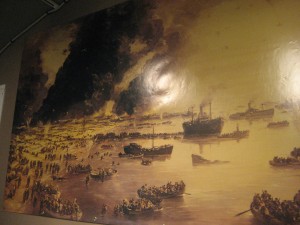
Johanne believes John’s father was in the boat at the centre bottom of the painting. She was unable to make out the ship’s name but the skipper had a beard and brown eyes.
We leave the museum reflecting on whether it was fate or planning that brought the British to Dunkerque, an optimum location for the evacuation. We remember another of our friends, Ken Jones, told us his dad had been at Dunkerque. It must have been a terrible time for the people in England as news gradually reached them of the disaster and then waiting for information concerning their loved ones. Like Dieppe, but on a much larger scale.
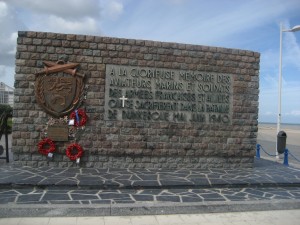
We walk to the beach and are amazed at its size. We could only imagine what it must have been like in 1940 with hundreds of thousands of soldiers waiting to be evacuated.

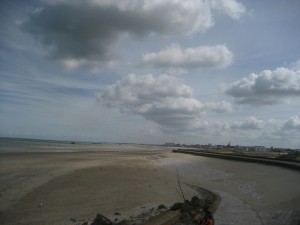
We walk down the beach towards the Mole (long narrow pier) and then back. As all the restaurants will stop serving in another hour, we decide to go for lunch at the L’Iguane restaurant on the boardwalk.
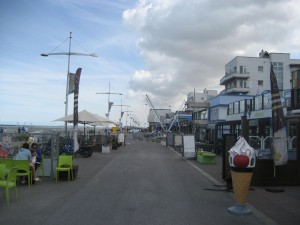
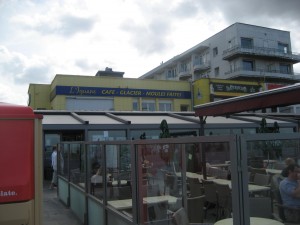
After eating ray and mussels, we cut short our plans to do more sight-seeing and return to the hotel. Johanne locks herself in the washroom in the hotel lobby and can’t get out. I go back for her about 15 minutes later wondering where she is but she has just broken out. Flustered, she recounts her imprisonment in infinite detail. We go back to the room and Johanne checks out the ferry schedule from Dunkerque to Dover while I nap. I wake up to the equivalent of “Houston, we have a problem.” “The only ferries travelling from Dunkerque to Dover are car ferries. They don’t carry pedestrians,” Johanne says as I rub the sleep from my eyes. “The only ferry that did has now gone bankrupt.” Needless to say she has my full attention. I go to the lobby to see if they can help (perhaps Johanne read the schedules wrong?) but they can’t confirm whether pedestrians are allowed. Okay, what’s plan B? For travellers on foot in Dunkerque going to Dover, The Lonely Planet suggests going to the ferry terminal, getting friendly with someone who has room in their car, and offering to pay half their fare. I don’t think so! We call Avis and tell them we want to drop the car off in Calais (30 minutes away) where there are pedestrian ferries (according to Johanne). They tell me to arrange it with the Calais office. I call but they are closed. So tomorrow, we have another interesting day ahead. Johanne has already written down the Google instructions on how to get there. Right! Tune in tomorrow to see how Johanne and Mike overcome this latest obstacle in their journey.
21 August – Travelling from Dieppe to Dunkerque
Today we enjoy a more relaxed morning. After breakfast, we checkout and move to the hotel’s piano bar where I finish blogging. While Johanne is busy, I go out to get a local newspaper that covers the weekend events. There’s an interesting photo of our Governor-General in cycling gear preparing to test the local trails.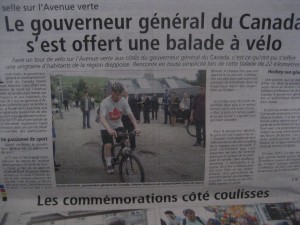 Of course, there are also many other great photos of the various commemoration ceremonies in the paper. Before we set off for Dunkerque, we go for lunch to a restaurant (Bas Blanc Fort) at the base of the chalk cliffs, probably not too far from where my dad landed.
Of course, there are also many other great photos of the various commemoration ceremonies in the paper. Before we set off for Dunkerque, we go for lunch to a restaurant (Bas Blanc Fort) at the base of the chalk cliffs, probably not too far from where my dad landed. 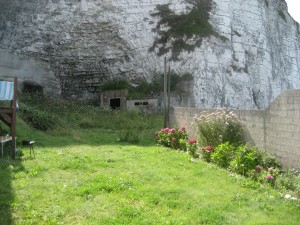 Johanne has the most delicious fish she has ever tasted in a Neufchatel cheese sauce while I have a nice salmon dish. We say goodbye to Dieppe, the beach, the cliffs that sheltered my dad on that fateful day in August, and to the great citizens who treat Canadians as their countrymen.
Johanne has the most delicious fish she has ever tasted in a Neufchatel cheese sauce while I have a nice salmon dish. We say goodbye to Dieppe, the beach, the cliffs that sheltered my dad on that fateful day in August, and to the great citizens who treat Canadians as their countrymen.
A slight hiccup leaving Dieppe, we miss the road out and have to circle back and then we are away – but not on the road Google would have us travelling. But the one we are on is taking us to where we want to go (Abbeville) so we carry on. We meet up with the A16 and then we fly (130K and we aren’t keeping up with traffic). We avoid the t problem at the toll booths we had last year (t – ticket) and make good time bypassing the lengthy back up of traffic at the exit at Calais, site of Chunnel & ferries to Dover. Exit 56 takes us into the outskirts of Dunkerque and now the fun begins. None of the $#%^^% streets have visible street signs with names. All our Google directions use street names. We rely on dead reckoning to get us close to where we should be but then roundabouts complicate matters with many exits but no clues as to where we should go. Last year’s training kicks in and I circle a roundabout at least 6 times waiting for a signal from my frustrated navigator. “Take this one,” she cries out only because she is getting dizzy. We end up in a maze of roads in some suburb of Dunkerque. I stop and ask directions and the gentleman lefts and rights me until my head is spinning. We do our best to follow the directions and end up back on the A16. Johanne thinks we should be headed in the opposite direction. I stop at a service area and explain our situation. The fellow behind the counter starts to draw a map on our Google directions, but quickly realises this may further complicate matters. He retrieves a map of Dunkerque from the shelf and uses it to explain the route to our hotel. This isn’t going to work. I tell him I’ll buy the map if he uses a marker to highlight the way. A few minutes later, we’re back on the A16 but headed in the opposite direction to what we thought. We pass our Google exit 56 and carry on to exit 60. Ten minutes later, we are at our hotel, the All Suites Apart Hotel. We’re both pleasantly surprised at how nice our room is – equipped with a little kitchenette and a view overlooking the port. Our 3 hr journey took us about 4.5 hrs. We’re too wound up from the day’s excitement to enjoy a nice supper in a restaurant. We would love a glass of wine and something simple but we don’t want to venture out again in the car. Johanne finds a Pizza Hut pamphlet and they not only deliver, they also sell wine. Make that a pizza supreme with classic crust and une bouteille de rosée! That’s it for today.
Tomorrow we are off to the Operation Dynamo Memorial that covers the dramatic escape of over 300,000 British, French and Belgium forces from the German encirclement in May-June 1940. Johanne’s mission tomorrow is to try and find which ship our friend John Welbourn’s father was on when he was evacuated from Dunkerque.
20 August – Dieppe Day 3 (afternoon) – Envermeu, Berneval, Saint Martin de Campagne
We get back to the hotel, freshen up, race down to the pedestrian mall, and look for the book Raid de Dieppe at the store McPress. Johanne is desperate to have the book because Mathieu said he would autograph it for us. With the clock ticking (remember the bus leaves at 15:15 and it is now 15:00) we run down the street, find the bookstore and buy the book. It is now 15:12. We start running towards city hall where we hope to find the buses still waiting. Bogged down by the weight of her purse, running in her sandles, and carrying our lunch, and the new book, Johanne falls behind telling me to go on. I do (I guess I should have offered to carry something), and after a few blocks, I turn the corner, ignore the red light, and rush across the boulevard. At city hall, I find the 3 buses sitting with no one (not even the drivers) in them. I gesture for Johanne to slow down. We sit, rest, and she eats the lunch I picked up earlier. I decide to save mine for later.
Our first stop is Envermeu, a little town about 11 km from Dieppe. After receiving treatment at the Hotel Dieu Hospital, this is where battered Canadian POWs were marched, carrying their wounded. We stop at the church where the officer POWs spent the night.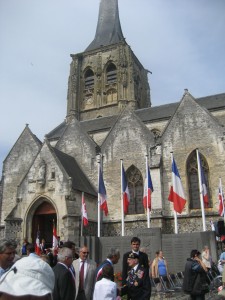
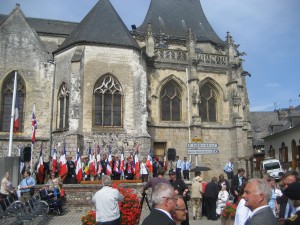 The enlisted men were marched to an abandoned factory some 6 km away. Mathieu shows Johanne several photos in his book of the soldiers in front of the factory. “Darn,” she says. “I wish I would have seen these last year when we were here looking for the factory!” The ceremonies began with speeches by dignitaries and Jacques Nadeau, laying of wreaths and singing of national anthems (a few more ceremonies and I’ll be singing La Marseillaise too).
The enlisted men were marched to an abandoned factory some 6 km away. Mathieu shows Johanne several photos in his book of the soldiers in front of the factory. “Darn,” she says. “I wish I would have seen these last year when we were here looking for the factory!” The ceremonies began with speeches by dignitaries and Jacques Nadeau, laying of wreaths and singing of national anthems (a few more ceremonies and I’ll be singing La Marseillaise too).
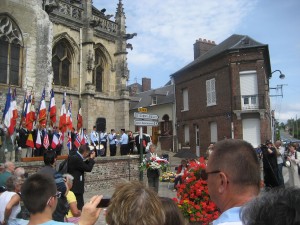
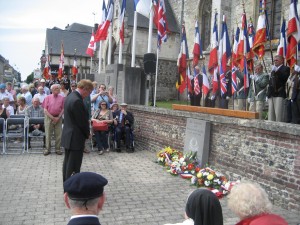 Johanne is busy with Mathieu and one of the other authors, Nicolas Bucourt, reviewing ours and his book. Mathieu sees photos of Iceland in ours that he doesn’t have. She offers to email copies to him.
Johanne is busy with Mathieu and one of the other authors, Nicolas Bucourt, reviewing ours and his book. Mathieu sees photos of Iceland in ours that he doesn’t have. She offers to email copies to him.
Next stop is Berneval, the site where No 3 British Commandos and U.S. Rangers landed. Mathieu decides to join us on the bus so he could chat some more with Johanne about Les Fusiliers Mont-Royal. On the bus, I chat with Christophe, a former paratrooper in the French No 4 Commando Unit. He is extremely proud of his 7 years of service and judging by his looks, he must have been quite intimidating to the bad guys. I tell him of my dad. He listens intently and then makes me a promise, a promise from a former commando. Each time he will fish at the beach at Dieppe, he will lay a flower at the memorial for Les Fusiliers Mont-Royal. I am overcome by the emotion of the moment and can’t respond, other than with the tears in my eyes. 
At Berneval, citizens of the town are sitting in rows of plastic chairs anxiously waiting for our arrival. Amazing!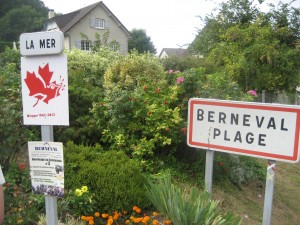
 . Ceremonies begin – speeches, wreath laying, and National Anthems.
. Ceremonies begin – speeches, wreath laying, and National Anthems. 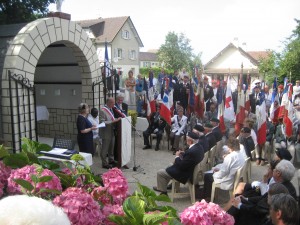
 . We walk a short distance to St Martin de Campagne to lay wreaths at the memorial for those killed in the attack. The cliffs and the sea are so beautiful. Its hard to imagine that 70 years ago, so many young soldiers lost their lives here.
. We walk a short distance to St Martin de Campagne to lay wreaths at the memorial for those killed in the attack. The cliffs and the sea are so beautiful. Its hard to imagine that 70 years ago, so many young soldiers lost their lives here. 


This is the site of the 1st U.S. casualty of WWII. Lieutenant Edward Vincent Loustalot died attacking a German machine gun position at the top of the cliffs. At this point, my camera battery dies (the 2nd time over the last 3 days). Johanne gives me a look but says nothing. I guess a second battery would be a good idea. After a moving ceremony at the memorial that included the laying of a wreath by a U.S. Senator from Michigan, we retire to tables set up nearby filled with canapés and champagne. The town put on a wonderful spread for us. Around 8:00 pm the bus takes us back to the city hall in Dieppe. An emotional end to 3 days of touching and heartfelt ceremonies!
I must add a few comments here about the 70th anniversary. The effort, dedication, sincerity, and contribution of French organisers and citizens to make this event a success astound me. They are passionate about implanting the memory of 19 August 1942 in their young. In the morning, we met Celia Godard and her 17 yr old son Julian on our bus. They are from Dieppe and have been attending the 19 August 1942 commemorate ceremonies since Julian was in a stroller. Like many of the Dieppe citizens, they recognise the sacrifices of those young Canadians who gave their lives or their freedom for the Dieppois. They are genuinely interested in Canadians, our lives, and our families’ stories from the war. They listen so attentively about the soldiers – they want to know everything about them, their names, where they came from, and what brought them to fight for another countries’ freedom. During every ceremony from the 18th to the 20th August, and in every town on the busy commemorative agenda, small Canadian flags were everywhere. French citizens, young and old, held the flag proudly, as if it were their own. On everyone’s lapel was a poppy. They have adopted us. We have bonded and become one.
Merci infiniment
20 August – Dieppe Day 3 (morning) – Pourville, Varangeville, Ste Marguerite sur Mer
Another quick breakfast as the buses will leave at 08:30. We aren’t sure if public are included. When we arrive, everyone appears to be in some sort of formal dress. Just in case, we’ve brought our Jubilee Association name tags, but we don’t need them, everyone is welcome. Our first stop is Pourville, where the South Saskatchewan and Queen’s Own Cameron Highlanders landed.
 The local citizens surround the ceremonial area and various military regiments and Les Fusiliers Mont-Royal band set up beside the church where the ceremonies are to be conducted. Eventually the dignitaries and officials arrive and the commemoration begins. The Governor-General David Johnston inspects the troops
The local citizens surround the ceremonial area and various military regiments and Les Fusiliers Mont-Royal band set up beside the church where the ceremonies are to be conducted. Eventually the dignitaries and officials arrive and the commemoration begins. The Governor-General David Johnston inspects the troops 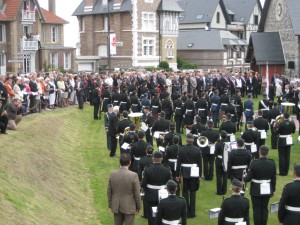 and the speeches begin. Johanne reminds me several times that the Canadian Ambassador to France, Lawrence Cannon is also present. The Honourable Steven Blaney puts tears in my eyes when towards the end of his speech, his voice quivers, and his tears flow as he speaks of the raid and acknowledges the brave veterans seated in front of the memorial. The Fusiliers band plays and the tears are now flowing freely including the two couples we met on our first day from Winnipeg. Once the laying of wreaths and playing of national anthems are complete, we move down to the beach and assemble near a small bridge. It was here in 1942 Lieutenant Colonel Merritt and the Queen’s Own Cameron Highlanders of Canada attempted to cross the Scie River to reach their objective.
and the speeches begin. Johanne reminds me several times that the Canadian Ambassador to France, Lawrence Cannon is also present. The Honourable Steven Blaney puts tears in my eyes when towards the end of his speech, his voice quivers, and his tears flow as he speaks of the raid and acknowledges the brave veterans seated in front of the memorial. The Fusiliers band plays and the tears are now flowing freely including the two couples we met on our first day from Winnipeg. Once the laying of wreaths and playing of national anthems are complete, we move down to the beach and assemble near a small bridge. It was here in 1942 Lieutenant Colonel Merritt and the Queen’s Own Cameron Highlanders of Canada attempted to cross the Scie River to reach their objective. 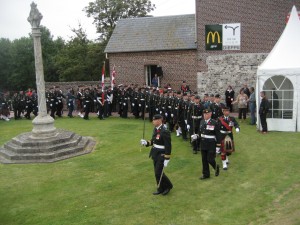 Leaving the church grounds We follow the parade as it moves along the promenade by the sea wall and stops for one more salute.
Leaving the church grounds We follow the parade as it moves along the promenade by the sea wall and stops for one more salute.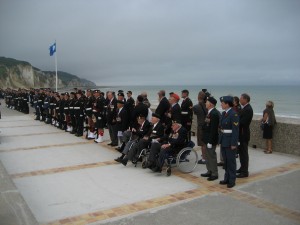 Johanne is chatting with the veterans and some of the locals when I notice that there are more officials and dignitaries than public. We head back to the main street and our bus. The street is empty! I ask a gendarme where the buses are parked. He says they left 10 minutes ago – ahead of the veterans, band, dignitaries, etc. because they are behind schedule on the agenda. Responding to our predicament, he arranges travel for us – one of the elected officials offers us a ride. When we get to the next stop on our agenda, Varangeville, Johanne says “there’s our buses!”. The official says we are too late for the ceremony and he wants to be early for the next town so we head straight to Sainte Marguerite-sur Mer. Unfortunately we missed the ceremony commemorating the only successful operation! We arrive well before the rest of the entourage and stake out prime spots to view the ceremony coincidentally near the memorial honouring the No 4 British Commando unit that attacked Varangeville.
Johanne is chatting with the veterans and some of the locals when I notice that there are more officials and dignitaries than public. We head back to the main street and our bus. The street is empty! I ask a gendarme where the buses are parked. He says they left 10 minutes ago – ahead of the veterans, band, dignitaries, etc. because they are behind schedule on the agenda. Responding to our predicament, he arranges travel for us – one of the elected officials offers us a ride. When we get to the next stop on our agenda, Varangeville, Johanne says “there’s our buses!”. The official says we are too late for the ceremony and he wants to be early for the next town so we head straight to Sainte Marguerite-sur Mer. Unfortunately we missed the ceremony commemorating the only successful operation! We arrive well before the rest of the entourage and stake out prime spots to view the ceremony coincidentally near the memorial honouring the No 4 British Commando unit that attacked Varangeville.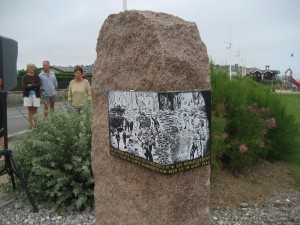 We have plenty of time to talk to the locals, who have been waiting for some time for the delegation. Everyone is so passionate about their local history. Young children, teenagers, and older people who were probably just kids when the raid took place surround the cordoned off area. When they see that we are Canadian they are very interested in our story. “You came all the way from Canada to be here? Thank you!” It brought tears to our eyes. The officials finally arrive and the site fills with our people from the buses.
We have plenty of time to talk to the locals, who have been waiting for some time for the delegation. Everyone is so passionate about their local history. Young children, teenagers, and older people who were probably just kids when the raid took place surround the cordoned off area. When they see that we are Canadian they are very interested in our story. “You came all the way from Canada to be here? Thank you!” It brought tears to our eyes. The officials finally arrive and the site fills with our people from the buses. 
 A small French military band replaces the Fusiliers’ band
A small French military band replaces the Fusiliers’ band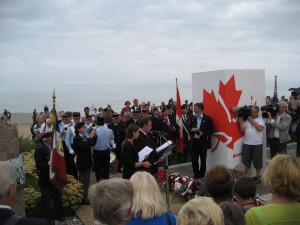 and the ceremonies begin with speeches, wreath laying, and national anthems. The French sing theirs with gusto and pride.
and the ceremonies begin with speeches, wreath laying, and national anthems. The French sing theirs with gusto and pride.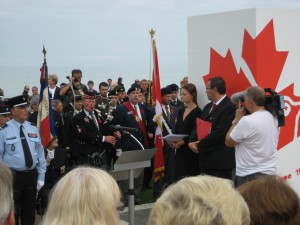 We then move to an old brick building that has numerous plaques acknowledging the No 4 Commando.
We then move to an old brick building that has numerous plaques acknowledging the No 4 Commando. 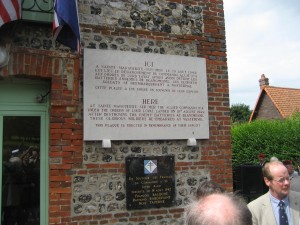
 More speeches, wreaths and anthems. A child stood on a wall above the crowd waving her own little flag.
More speeches, wreaths and anthems. A child stood on a wall above the crowd waving her own little flag. 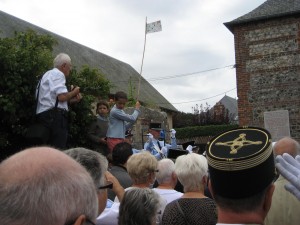
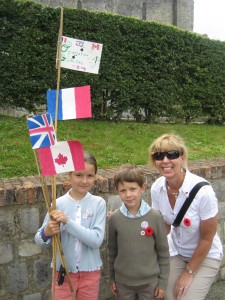 When the ceremony ended, Johanne gave the little boy a poppy and I took their photo with their handmade flags. Remembering 19 August 1942 is in genes of the French people!
When the ceremony ended, Johanne gave the little boy a poppy and I took their photo with their handmade flags. Remembering 19 August 1942 is in genes of the French people!
Our next stop is a reception with petit canapés and champagne for everyone. 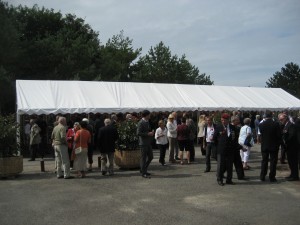 I break out a sandwich I prepared at breakfast. People passing me search the spread for similar, substantial handouts, but désolé, there are none. Johanne spots two young men holding large books. She approaches them and notices that one of them has the Fusiliers emblem on his jacket and the other has the Cameron Highlanders crest. She finds out that they are French citizens but are Fusiliers and Queen’s Own Cameron Highlanders representatives (Mathieu Masson and Frederick Jeanne respectively). She asks them where they got the beautiful book on Dieppe and they tell her that they wrote it with 2 other historians. Sure enough their pictures are on the back cover! Well that was it for Johanne – you couldn’t drag her away. There they were comparing notes and photographs from my book. He told her that she should be able to buy it at small bookstore in Dieppe. They had so much to talk about that Mathieu Masson, the Fusiliers representative decided to meet us on out next agenda stop at Envermeu at 4:00pm.
I break out a sandwich I prepared at breakfast. People passing me search the spread for similar, substantial handouts, but désolé, there are none. Johanne spots two young men holding large books. She approaches them and notices that one of them has the Fusiliers emblem on his jacket and the other has the Cameron Highlanders crest. She finds out that they are French citizens but are Fusiliers and Queen’s Own Cameron Highlanders representatives (Mathieu Masson and Frederick Jeanne respectively). She asks them where they got the beautiful book on Dieppe and they tell her that they wrote it with 2 other historians. Sure enough their pictures are on the back cover! Well that was it for Johanne – you couldn’t drag her away. There they were comparing notes and photographs from my book. He told her that she should be able to buy it at small bookstore in Dieppe. They had so much to talk about that Mathieu Masson, the Fusiliers representative decided to meet us on out next agenda stop at Envermeu at 4:00pm.  The bus arrived back at Dieppe city hall at 2:15 and we had less than 1 hr to freshen up, look for the book on Dieppe, pick up something to eat (Johanne had been so busy talking to Mathieu that she forgot to eat at the reception) and get back to the bus by 3:15 pm. When we get off the bus we make like Usain Bolt.
The bus arrived back at Dieppe city hall at 2:15 and we had less than 1 hr to freshen up, look for the book on Dieppe, pick up something to eat (Johanne had been so busy talking to Mathieu that she forgot to eat at the reception) and get back to the bus by 3:15 pm. When we get off the bus we make like Usain Bolt.
19 August – Dieppe Day 2 – The day of days
After a quick breakfast, we head out to the Square du Canada where the main ceremonies are to take place to commemorate the 19 August 1942. It’s 9:30 am and people are already gathering even though the ceremonies don’t begin for almost an hour. After 1.5 hrs of standing, we see activity! The Fusiliers Mont-Royal band marches in followed by other units of the Canadian forces and a small contingent of French soldiers.
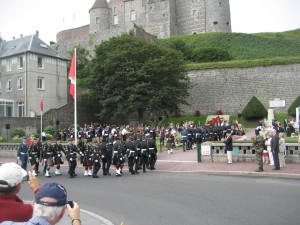
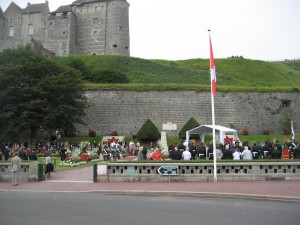
Johanne’s Royal Navy boyfriend George from the night before turned up to lay a wreath.
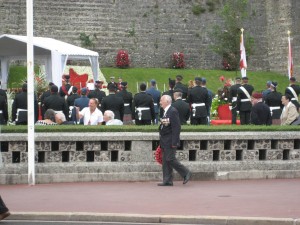
Other veterans, legion members, dignitaries, and officials begin arriving including the Honourable Steven Blaney (Minister of Veterans’ Affairs), and David Johnston (Canada’s Governor-General).
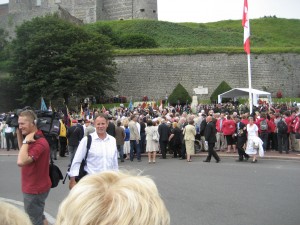
The mayor of Dieppe gives a very touching speech acknowledging the sacrifice made by Canadians and the close bonds between Dieppe and Canada. The crowd, including many Dieppois, is now 5 to 6 rows deep,trying hard to make it through the heat since many of us have now been standing for over 2 hrs. Unfortunately some older folks collapse but the paramedics standing by take good care of them. As the commemorations are ending, we walk to the Fusiliers Mont-Royal monument on the promenade where Fusiliers veterans will be laying a wreath. While we are waiting for the military procession, a British Spitfire makes several low passes over the beach which stirs the emotions of all. The Fusiliers’ band marches by followed by a small group of mixed Canadian military that stop to pay their respects.

Two Fusiliers veterans lay a wreath at the memorial that marks the spot where most of the Fusiliers came ashore that terrible day.
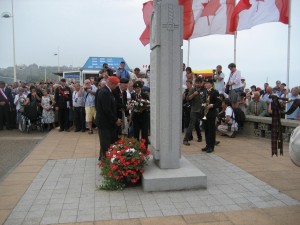
The procession with Governor-General David Johnston carries on to the next monument along the beach.
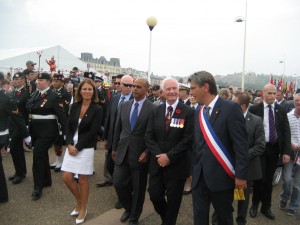
Veterans’ Affairs Minister Steven Blaney stays behind for photos at the monument with the Fusiliers’ Commanding Officer Lieutenant-colonel Francis Roy, retired Commanding Officer Lieutenant-colonel Guy Gosselin and another Fusilier officer.
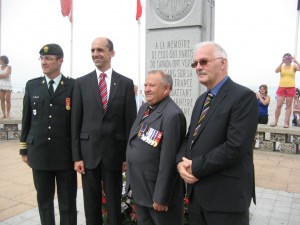
We then went to a large reception tent where the mayor of Dieppe presented Jacques Nadeau with a medal of honour from the city of Dieppe.
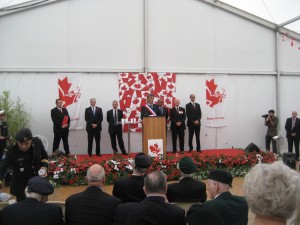

The Honourable Steven Blaney, David Johnston as well as other dignitaries from England and France were present and gave very touching speeches. I managed to get a photo of Jacques Nadeau who I met the night before.
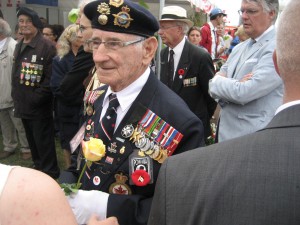
Emotionally and physically drained from standing in the hot sun for over 5 hrs, Johanne and I decide to forego the gracious invitation to supper at 9:00 pm tonight from the Association Jubilee. We get something to eat at the only restaurant still serving and retire to our hotel. Tomorrow begins at 8:30 am with a bus tour of other landings sites – Pourville, Varangeville, Ste. Margueritte, Berneval, and to Envermeu, the town 13 km from Dieppe where the weary and battered prisoners were marched by the Germans after the battle.
18 August – Dieppe Day 1
Seagulls woke us at 9 am. Off to breakfast where we met two nice couples from Winnipeg, one whose father also fought at Dieppe with the Queen’s Own Cameron Highlanders of Canada. They asked if we knew where the Canadians went after they were captured. Luckily, we had my book with us to explain most of the events during that fateful day on 19 August 1942. After breakfast, we went to the Museum (Mémorial 19 août 1942) to see Alain Caillet (one of our contacts) but it was closed until the afternoon. We then walked to the promenade to see the recreation of a military encampment. Lots of interesting displays but the abundance of U.S. equipment and signage confused us (there were only 50 U.S. Rangers at Dieppe). We asked one of the men looking after an armoured car and he explained the U.S. Army sold equipment to the French Army after the war. The French military later sold the vehicles and gear to French citizens who restored, maintained and displayed their vehicles with a passion. He told us he finds parts and authenic uniforms through eBay and other sources. It’s an expensive but much-loved hobby of many in France.
As we walked about, we spoke with many veterans, a very moving and emotional experience. We talked with a Free-French veteran who now lives with his family on the Isle of Wight in England.
We met some fellow Canadians who are now retired from the Air Force (Gary & Irene George). They told us where the POWs’ train stopped after they left Verneuil-sur-Seine when they were enroute to the German POW camps. It was in Momignies, a town in Belgium. The townsfolk wanted to give food and water to the POWs but the Germans threatened to shoot anyone providing nourishment. Doing research about this town has been their passion for many years.
At 3:00 pm we went to the Mémorial 19 août 1942 museum for a ceremony which included many official dignitaries from Canada and France. The town of Longueil, Quebec, presented Dieppe with a flag, a painting was presented to Canadian dignitaries, a contingent from Scouts Canada made a presentation, a widow of a Fusiliers Mont-Royal veteran presented the museum with a regimental flag, and other official presentations were made. We also saw the legendary Sister Agnes Valois, a French Sister who helped the wounded at Dieppe. She’s now 98 years old!
After the ceremony, we decided to skip some of the bus tours and instead opted to walk around the town to meet and talk to veterans. The town was packed with tourists, veterans and their families who were here for the 70th anniversary ceremonies. We spoke to a few more people and then headed off to supper. The Tout Va Bien restaurant treated us to mussels and marmite Dieppoise (a type of fish stew) which included some giant snails. While at the restaurant, I spoke to a British veteran from Lewes, England, just up the road from where my mother and father met in Northease. He laughed and spoke fondly of the Canadians who were based in the area.
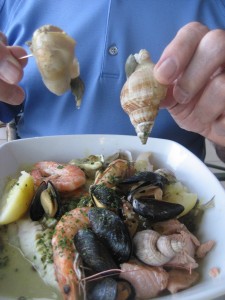
At 8:00 pm we went to the city hall where we waited for buses to take dignitaries, veterans, and public to the Canadian War cemetery. There I met Jacques Nadeau, a much-decorated Les Fusiliers Mont-Royal veteran of Dieppe who knew my father and Maurice Jolicoeur. We chatted with a few other people then headed off in buses to the cemetery with a police motorcycle escort guiding us through roundabouts and red stoplights. Johanne befriended a Royal Navy veteran who missed taking the veterans’ bus. Believe it or not, the 91 year-old was hitting on my wife. There were over 500 people at the cemetery and when the ceremonies began, a fog came drifting in. Johanne said they were the ghosts of the fallen Canadian soldiers joining us. The ceremony was extremely moving and we both had tears in our eyes all the time we were there. We arrived back at the hotel around 11:00 pm and called it a night.
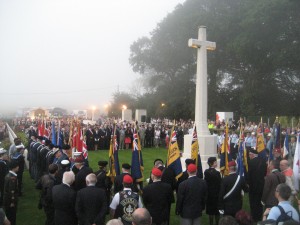
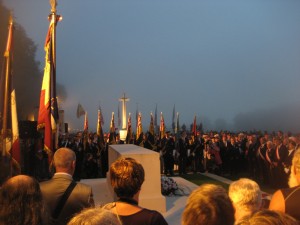
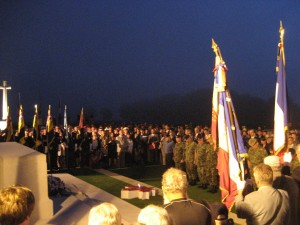
17 August – In Transit to Dieppe
The plan is to fly to Paris on Aug 16, arrive around 10 a.m. on Aug 17, take the train from the Charles de Gaulle airport to Paris Gare de Nord, then either another train or metro to the Paris St Lazare train station (where the trains to Normandy leave from). This is supposed to be faster than a taxi from the airport to the St. Lazare station which could take over an hour depending on traffic. From the St Lazare station catch the 12:20 RER (intercity) train to Rouen and take the 16:15 commuter train to Dieppe. Arrive at 17:00 at the Dieppe train station, pick up our rental car and drive the 5 min. to our hotel. Piece of cake!
The flight was uneventful, if you call a continuously screaming child uneventful. Needless to say, we didn’t get much sleep and were delighted when we finally were able to get off the plane. We taxied to a remote part of the airport and descended into buses that took us to Terminal 3. The flood of passengers swamped the two or three Passport Control officers. When our turn came, it was 11:30. We got through without any problems but found out the airport train station is in terminal 2, an easy 3 minute walk, according to a cheerful cab driver. The 3 minutes seemed longer, especially since it was over 30C and we were not dressed for a steam bath. At terminal 2, we find the station but now have to buy tickets. A weaving Disney-type line of people was snaking its way to the counter where two clerks were trying their best. There were probably 20 people ahead of me. I rush over to the less congested do-it-yourself machines and wait my turn. I managed to request 2 tickets to Paris but the machine refuses to accept my Visa. The machine will take money but only coins and all I’ve got are paper Euros. Desperate I try again and then realise I’ve been inserting my card in the wrong slot (who knew there would be two). Tickets bought, we rush off to catch the next train. We thought we might get off at Chatelet-des-Halles and then take the metro to St. Lazare because the metro probably runs more frequently than the train. The only problem was this train stops at Gare du Nord, one stop before Chatelet-des-Halles. Ok so we go to plan B and decide to take the RER train from Gare du Nord to St Lazare. We get off in Paris Gare de Nord and ask directions to get to the RER train to St. Lazare. “Désolé, that line is closed for construction, but you can take the train over there and get off at Chatelet-des-Halles and then take the metro to the station.” We run for the waiting train, Johanne jumps on and then I pull her off. With what little time we have left, we won’t make our 12:20 train to Rouen by taking a train to a metro to a train station. We run up the stairs, go outside, and get a cab. Twenty minutes later, we are at the St Lazare station running down to platform 25 at the furthest end of the station where our train should be. Johanne is laughing – this is just like the Amazing Race! Good thing we only have carry-bags! “Désolé, the 12:20 left at 12:20,” said the ticket agent. “Merde!!!!” But the agent said not to despair. Your 1st class tickets are still good. Another train to Rouen will be leaving at 12:50. Things now get better. We catch the 12:50, arrive in Rouen with time to spare, enjoy a light lunch at a nice restaurant across the street from the station, and catch the 16:15 train to Dieppe (no air conditioning in any train and it’s still sweltering hot). We get our rental car even though for some odd reason my on-line file said, “No vehicle allowed.” The rental car agent couldn’t read English and didn’t know what it meant so asked us to translate. Johanne without hesitating told him it was nothing, just insurance coverage! Whew. He then apologized because the car hadn’t been cleaned (numerous seagull poop all over the windshield). He went and got a jug of water for us so we could fill the windshield washer in order to wash the poop off. After the 5 min drive to our hotel, we found a parking spot and got our room. No air conditioning and no shampoo! But who cares, its 6:00 p.m. – we’re done for the day!
